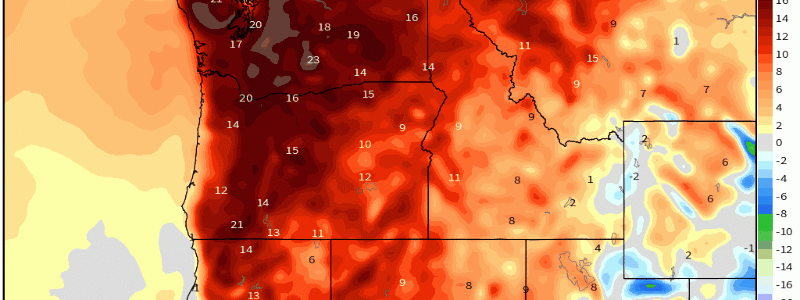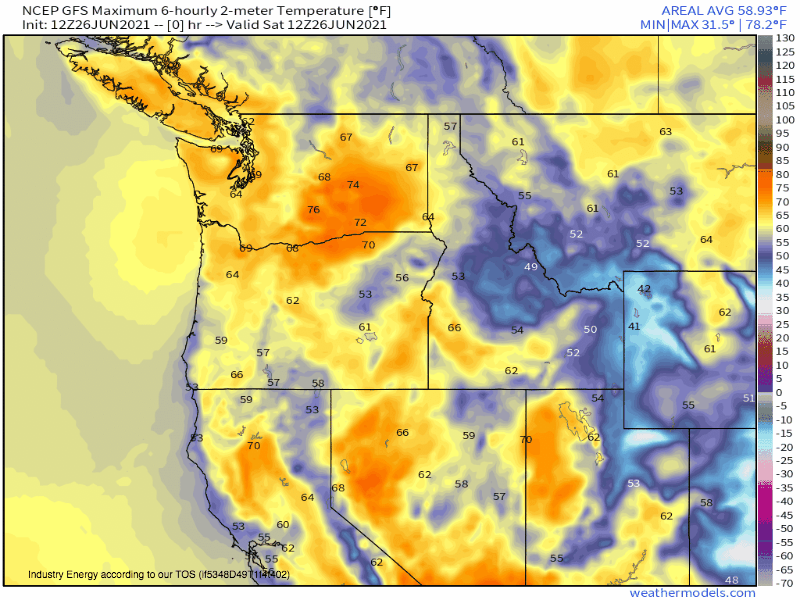
An Extreme Heatwave is Beginning to Batter the Northwest. Here’s What You Need to Know.
One of the most anomalous temperature events I’ve ever seen over the United States is currently roaring to life over the Northwest. In this blog, I’ll answer some questions you may have about what’s sure to be an extreme event.
How will the heat evolve?
Temperatures across the West will continue a steady swell today, with highs generally peaking in the ‘hot but not unprecedented’ range from north-central California to the Canadian border. This means high temperatures largely between 100ºF and 110ºF, which is hot enough to break daily records almost universally in the region, and challenge monthly records for some, but will keep all-time records safe. Today will see the heat’s peak in central California.
The thermal swell will continue tomorrow, as temperatures from Redding to Seattle crawl yet higher. Temperatures will reach the mid-110ºFs in places, including the fairly populous near-coastal valleys of Oregon and Washington. Heat will break daily records with ease, and will even challenge a number of all-time records. Sunday will be the hottest day of the heatwave for the populous corridor of eastern Oregon, including Portland. Nighttime lows in the mid to upper 70ºFs will also break all-time records for some and daily records for all.
Heat will shift north and east once again Monday, with highs in much of Washington and east Oregon higher even as temperatures cool somewhat in west Oregon and north California. Daily highs in the former will challenge all-time records, and even in the latter will break daily records. Monday will be the hottest day of the heatwave for populous western Washington, including Seattle.
After Monday, heat will continue to swell across the interior northwest, towards the Rockies. The eastern halves of Washington and Oregon will see the most focused heat next week, with wide rural areas, and a couple cities like Eugene, shattering daily records through next weekend. The most intense heat during this period will be over parts of southeastern Washington Tuesday, where temperatures will likely approach an astonishing 120ºF.
Is it really going to be that hot, or is all the hype just the media trying to get clicks?
Earlier this year, the nation watched in horror as a massive dip in the polar trough allowed temperatures ~50ºF below average to spill south into Oklahoma and Texas in mid-February. The devastating and tragic catastrophe that followed was evidence that, when tail-end temperatures correspond with seasonal cycles, vulnerabilities can be disastrously exploited. Obviously, most hot/cold spells aren’t so significantly impactful- the danger is when anomalies grow so high that a region simply lacks the necessary infrastructure to protect health.
A good way to figure out whether an event is rare enough to be dangerous is to determine the standardized anomalies involved. In this case, absolute anomalies of 25-45ºF in a region that doesn’t typically see that much summertime temperature variation will promote temperatures 4-7 sigma over the mean, a statistical rarity of mind-boggling proportions. Numerous all-time high highs and high lows will likely fall across the northwest, with some places potentially beating previous year-round records multiple times.
Earlier this week, I was skeptical about whether the heatwave would be as bad as some models were projecting. The answer, it seems, is that it will be.
At this level of anomalous, a weather event as seemingly insignificant as heat can become very, very dangerous.
Dangerous? How?
Vulnerabilities to temperature follow two paths: infrastructural and physical. Think back to Texas in February- the infrastructure of the area wasn’t built for the extreme cold (hence, pipes freezing and power failing), and people aren’t used to driving, dressing, and existing in it. This is analogous to what will happen in the Northwest this week. The normal high temperature this time of year in places like Seattle and Portland is in the mid 70ºFs, with lows in the 50ºFs, meaning many in the region don’t have much, if any, air conditioning. People also aren’t used to such heat, which can make it extra taxing. With daytime highs in the 100ºF-125ºF range, and nighttime lows hardly falling below 80ºF, the compound stressors on the body will be very significant.
For the physically and socially vulnerable, the heat forecasted to envelop the region could therefore prove very dangerous. This degree of heat can absolutely kill.
Another layer of vulnerability is the fact that the longest lasting, most intense heat will be over rural eastern areas of WA and OR. These areas may not have the same public cooling program capabilities as the more populous areas to the West, like air conditioned malls and public swimming pools.
Secondary dangers will compound as the heat increasingly dries already parched soil, causing drought conditions to spiral ever more intense. Besides stressing water reserves, this downward spiral will increase the potential for future heat waves, as dry earth is easier to heat up than moist earth. Finally, the heat and dry ground will promote the type of dry fuel that could prove deadly come fire season in the fall.
What should people living in the Northwest do to stay safe, and keep others safe?
First, have a plan in place to stay cool. Air conditioning is ideal, but many homes understandably don’t have systems given the climate, and AC units that are installed may prove insufficient. Here is a [non-exhaustive] list of 10 tips if AC alone can’t keep your house cool:
- Freeze ice packs and ice cubes ahead of time. The former can be pressed against a hot forehead for relief from the heat, and the latter can be used to make cold drinks
- Hydrate!! Going outside for an extended period? Bring at least a liter of water. Staying in? Make sure to drink as much as you need and then some. Heat and dehydration go hand in hand and can both be very dangerous.
- Learn the signs and symptoms of heat exhaustion and heat stroke. Don’t hesitate to seek help if needed.
- Install blackout curtains, which prevent solar energy from heating your home, and cook outside.
- Round up hand-held and portable fans to keep airflow.
- Spend limited time outside. If you have to work outside, have plenty of cold water with you, and take plentiful breaks in the shade. Wear lightly colored, loose fitting clothing.
- On the hottest day for your area (see above), take a trip to a coastal beach, a lake, a mall, a public pool, or a cooling center.
- Sleep in a cool place if possible. With nighttime lows this hot, it can be nearly impossible for the body to ‘recharge’ at night. The drone of fans and portable ACs may be hard to ignore while trying to sleep, but it’s better than risking long-term heat exhaustion.
- Avoid upper levels of houses if possible, especially for sleeping, as heat rises.
- Check on your neighbors! Especially be sure to keep an eye out for elderly, sick, or otherwise vulnerable people in your community. This degree of heat can seriously be dangerous.












